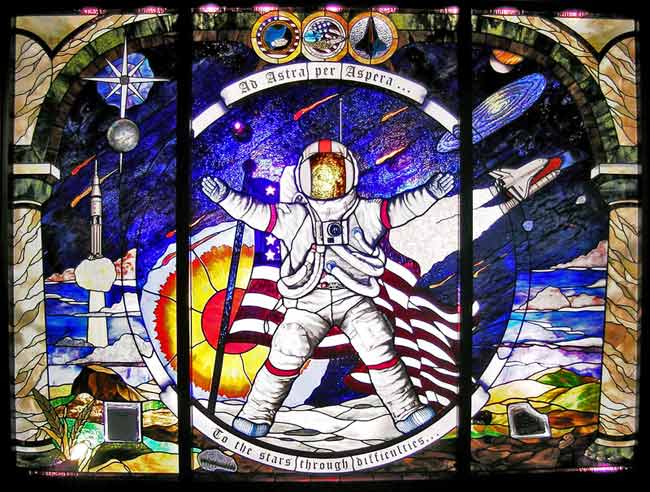Stained Glass Reflects on Astronauts' Lives

Beginningtoday, visitors to the Kansas Cosmosphere and Space Center in Hutchinson mayfind themselves moved to a more a reverential state of mind.
Unveiled duringa private ceremony Tuesday night, the Cosmosphere's latest addition is an8- by 11-foot (2.4- by 3.3-meter) stained glass creation that pays tribute to 17 fallen astronauts.
"Peoplewould actually walk by [it] and whisper... it had this glow about it, thisaura," said Randy Rayer, CEO and president of Rayer's Bearden StainedGlass Supply in an interview with collectSPACE.
"Youjust get this feeling [looking at the glass] that you should be reverent," he added.
Morethan just glass
Theartwork's design memorializes the men and women whose lives were lost in the1967 Apollo 1 pad fire and the in-flight accidents that occurred during spaceshuttles Challenger and Columbia's 1986 and 2003 final missions, respectively.
Etched intothe top of the glass are the names of the 17 fallen astronauts.
Breaking space news, the latest updates on rocket launches, skywatching events and more!
Central inthe glass's focus is an astronaut posed with outstretched arms and legs,reminiscent of Leonardo da Vinci's Vitruvian Man. Surrounding"him" are planets and galaxies, as well as a Saturn IB rocket andspace shuttle launching towards the heavens.
"Thethematics around [the astronaut] were a combination of symbols related to thetriumphs and tragedies of space flight," Cosmosphere President and CEOJeff Ollenburger told collectSPACE, "but their real purpose was tocapture the spirit of space flight -- even amidst the difficult times the needto explore needs to continue to come out."
"Wewrapped the Kansas state motto around [the Apollo astronaut] -- Ad Astra perAspera [To the stars through difficulty], and that really made this projectcome to life," said Ollenburger.
At the footof the glass are three encased artifacts that each have a connection to one ofthe lost crews.
"Theitems embedded in the glass are components from -- as it relates to the shuttleprogram -- two earlier flights that were removed after flight and part of ourcollection: a white tile and a black tile from Columbia and Challenger,"explained Ollenburger. "Then we worked with contacts in Florida to come upwith a piece of Pad 34, an electrical component, and that was our tangibletie-in to [Apollo 1]."
More thanjust one artist
At thebottom of the glass are the names of 19 artists, along with a description ofthe work they contributed to the piece.
"Therewere several people who really wanted to help," recounted Rayer, "soI hand selected 19 of some of the best glass artists in Kansas."
"Therewere certain artists that were good at fusing glass, some were good at leadingglass... so we split it up."
"Weactually had almost 4,000 hours [of artist time] in it," tallied Rayer.
"Just my two team members, Beth Palyash and Doug Bozeman, who I brought into just head up the project, they actually have 1,200 hours [between] the two[of them] together, changing drawings, choosing glass, calling artists, makingsure this went together, re-cutting something that wasn't right... I mean, theymight take an 8-foot (2.4-meter) square piece of glass and they might take just two inchesout of the center of it, because they want the color right here. They woulddestroy a whole sheet of glass to get just one asteroid," he added.
"I wasstanding in awe [of them] most of time, saying 'Oh my gosh, that's awesome.'So, I don't want to take all the credit," said Rayer. "I did put thepool together, but in the very end, everybody was swimming in it. It wasgreat."
Firstand lasting impressions
"Ihave to admit that pictures do not do it justice," said Ollenburger."The color detail and the texture changes as the light moves across it. Asyou stand before it and as you move around the piece, it just seems to comealive."
"That'sreally the tribute we were trying to accomplish," Ollenburger said.
"Thefuture of space flight is continuing and its always changing and it's alwaysmoving," he added. "It is as breathtaking as anything that you can imagine. Ithink that art does that. It does as good a job, or a better job than anythingof capturing something that most of us, unfortunately, will never get toexperience."
Above allelse, Ollenburger hopes that visitors will be able to relate the theme of thetribute to their own lives.
"Themajor theme of 'to the stars through difficulties' we hope resonates," he said. "Not allof us get to fly in space, but we have all faced challenges and all have haddark moments that we can either choose to emerge from and continue to pushourselves, or we can accept that fate and regress. Space flight is all aboutpicking up that torch from those who have gone before us and continuing thatjourney; not forgetting that sacrifice but learning from it."
"Ithink there is a tremendous spirit that can be shared with everybody when youaccept that challenge and keep the mission going," Ollenburger said.
Copyright 2006 collectSPACE.com. All rights reserved.

Robert Pearlman is a space historian, journalist and the founder and editor of collectSPACE.com, a daily news publication and community devoted to space history with a particular focus on how and where space exploration intersects with pop culture. Pearlman is also a contributing writer for Space.com and co-author of "Space Stations: The Art, Science, and Reality of Working in Space” published by Smithsonian Books in 2018.
In 2009, he was inducted into the U.S. Space Camp Hall of Fame in Huntsville, Alabama. In 2021, he was honored by the American Astronautical Society with the Ordway Award for Sustained Excellence in Spaceflight History. In 2023, the National Space Club Florida Committee recognized Pearlman with the Kolcum News and Communications Award for excellence in telling the space story along the Space Coast and throughout the world.
